OnePlus 2 Review
OnePlus proudly boasts that its latest smartphone is a "flagship killer." Does the OnePlus 2 have the arsenal to slay its competitors or is its metal chassis just filled with hot air?
Why you can trust Tom's Hardware
Software
The North American version of the OnePlus 2 runs OxygenOS (v2.1.0), OnePlus' custom Android ROM currently built on top of Android 5.1.1. Unlike many OEMs, OnePlus mostly leaves Google's stock UI alone. All of Lollipop's smooth animations and transitions remain in place along with Material Design icons and elements. While many other phones come preloaded with a large number of apps most users will never use, the OnePlus 2 comes preloaded with Google apps and little else beyond the SwiftKey Keyboard. In a market where many OEMs seemingly modify Android for the sake of being different, this is a breath of fresh air. This Nexus-like approach also leads to Nexus-like performance that is smooth and quick.
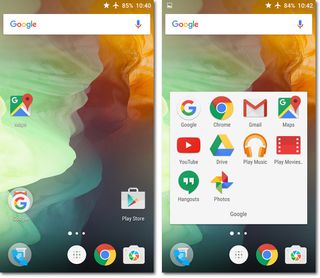
This is not quite a Nexus device, however. OnePlus makes a few useful additions, one of which is the option to customize aspects of the UI. Pulling down the notification shade twice reveals the usual options for quick settings—a brightness slider along with toggles for WiFi, Bluetooth, etc. There's also a small grid icon in the upper-right corner. Tapping this pulls up an option to rearrange the toggles as well as add toggles or remove ones that are not used.
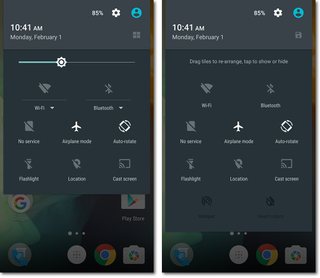
Other parts of the UI are customizable as well. Digging through the "Customization" heading within Settings reveals options to enable a system-wide dark theme, change the accent color used with the dark theme, and a customization tool for choosing what color the LED should flash during certain events. The dark theme only applies to system menus and not apps from Google or third parties, though.
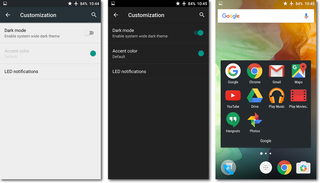
Long pressing on a home screen brings up the usual options for wallpapers, widgets, and settings. However, the settings icon brings up options to change the system icon pack as well as adjust the grid size of the app drawer. There are two additional options here as well: “Rearrange,” which moves icons around on the selected home page, and “Clear,” which clears everything off the page. A helpful “Undo” option also pops up when either of the previous options are selected. OnePlus keeps the app switcher very close to stock Android, but adds a circular icon in the top-right corner for clearing all apps at once.
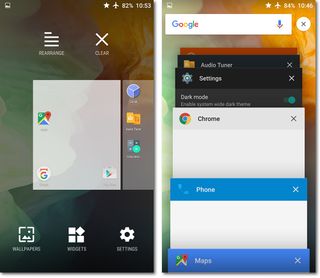
Customization is not just limited to the UI, even the buttons can be modified. Looking under the “Buttons” heading in Settings reveals a variety of options. The software-based onscreen buttons can be activated for a more Nexus-like experience, the order of the capacitive Recent and Back buttons can be switched, and the backlight for the capacitive buttons can even be switched off if the user so desires. Sticking with the capacitive buttons, however, opens up even more options. The Back, Home, and Recent keys each have options to map certain actions to a long press and a double tap of each respective button, a total of six shortcuts. This reviewer found it very useful to be able to double tap the Home button and have the camera launch right away and long press the same button to turn the screen off.
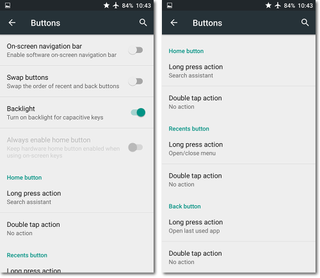
OnePlus also adds a variety of gestures the user can perform while the screen is off, which can be seen in the screenshot below. These gestures generally work well, however, on a few occasions the phone would not respond. This seems to occur more often after the phone has been idle for awhile. It’s possible the touch controller goes to sleep after a period of inactivity.

One of the new features on the OnePlus 2 is a fingerprint scanner. Since it’s not running Marshmallow, it’s not using Google’s new fingerprint API, relying on a third-party solution instead. Diving into the “Fingerprint” section in the Settings menu reveals the ability to save up to five unique fingerprints that can be used to unlock the device. Clicking on “add fingerprint” guides the user through a simple process of placing a finger on the sensor and lifting it when a vibration is felt. Each vibration is accompanied by a progress indicator around a fingerprint symbol as the scanner gathers more information. Once the progress indicator hits 100 percent, a popup informs the user that the fingerprint has been saved along with options to finish or add another.
For the most part, the fingerprint scanner is fast and flawless and provides a similar experience to that of an iPhone or Galaxy S6. It can read the fingerprint regardless of the finger’s orientation relative to the sensor. Like all capacitive fingerprint scanners, the OnePlus 2’s has trouble with wet or cold fingers, and occasionally it requires additional repositioning of a digit before it reads correctly and unlocks.
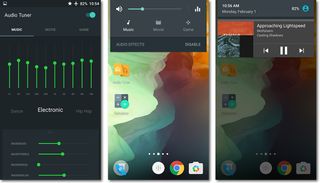
Aside from stock Google apps, the OnePlus 2 comes with the “Audio Tuner” app for fine tuning your listening experience. It includes a 10-band equalizer and a selection of useful presets for different genres of music. Unlike most equalizer apps that do more harm than good, this one is actually quite effective.
As shown in the screenshot above, quick settings for the “Audio Tuner” app pop up along with the volume slider when the volume is adjusted while listening to music or watching a video. This is useful, but the addition of the quick settings increases the size of the volume shade, which can be distracting.
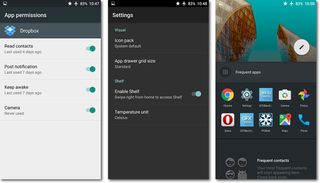
Another feature OnePlus adds is a key feature of Android Marshmallow: more granular app permissions. Under “App permissions” in the Settings menu is a list of installed apps. Clicking an app brings up a list of permissions with toggles to turn them on or off. It’s not a complete system, though; not all apps are listed and the ones that are do not show every possible permission. It’s more than one finds in stock Android Lollipop, at least.
There’s also a feature OnePlus calls “Shelf.” When enabled, it adds a specialized home screen that holds a selection of frequently used apps and contacts you’ve communicated with recently. The functionality is fairly limited at this point, but this could be extended in the future.
In its current form, OxygenOS sticks close to Google’s stock Android experience, but adds some useful features usually seen in custom launchers and ROMs, including the ability to customize various aspects of the UI, mapping buttons to different actions, gesture controls, and better control over app permissions. The rest is pure Google.
Current page: Software
Prev Page Camera Performance And Photo Quality Next Page CPU And System PerformanceStay on the Cutting Edge
Join the experts who read Tom's Hardware for the inside track on enthusiast PC tech news — and have for over 25 years. We'll send breaking news and in-depth reviews of CPUs, GPUs, AI, maker hardware and more straight to your inbox.
-
ChuckUfarleys How much did Oneplus pay you for this inane review that is for a phone that is 6 months old?Reply
You reviewers NEVER bring up the terrible customer service, the terrible buggy Oxygen O.S., the constant everyday posts about how bad the Two is in their own forum.
Why would you even use the One for comparison, it's a TWO year old phone!
Why is that, are you too afraid to NOT recommend this phone? -
juanjovargas @ChuckUfarleys then a half-price and 6-months-old phone is comparable in terms of performance to the best phones of every brand? YESReply -
ctmk I rather get a redmi note.Reply
https://www.youtube.com/watch?v=gGLW-kzh6sI
the CPU is only effectively quad core 1.55ghz and will throttle to 800mhz in just few min of video soft decoding stress test. -
ubercake Looks like the new ZenPhone with its 3x optical zoom on the rear-facing camera may also be a looker in this price range.Reply -
Abdurrasheed Desai Lol the OP2s price just went down. It is more worth it now than it ever was.Reply -
mellis I still like my OnePlusOne. It also works great with Straigthtalk. No contract and no bloatware is the way to go! No way am I going to over $400 for a phone.Reply -
Spinachy Operating Systems all have security problems that need to be patched regularly. This is an important buying consideration for me. You do not mention on what schedule OnePlus will be patching the OS?Reply -
zvancu I own a OnePlus 2 and I have to say that I would wish that at least one of the reviews I see online would mention how terrible their customer support is. It seems that it's pretty common knowledge, but I never saw this before actually buying the phone.Reply
I have to say that at first I was happy with the device, but now I am having some issues with it and I contacted the support. At first they were stalling with some meaningless questions (like what's my IMEI even I had already provided it) but now I got to the point where they are simply ignoring me. It has been more then a week in which I wrote 5 messages and they did not even acknowledge that they saw them, not to mention actually doing something. -
jacobian The bottom line it seems, there is no need to upgrade if you already own a Oneplus One. I have one Oneplus One (64GB) in the family running the stock CyanogenOS, and I see no reason to upgrade it. Very good smartphone all around. Hope the next generation will be better.Reply
